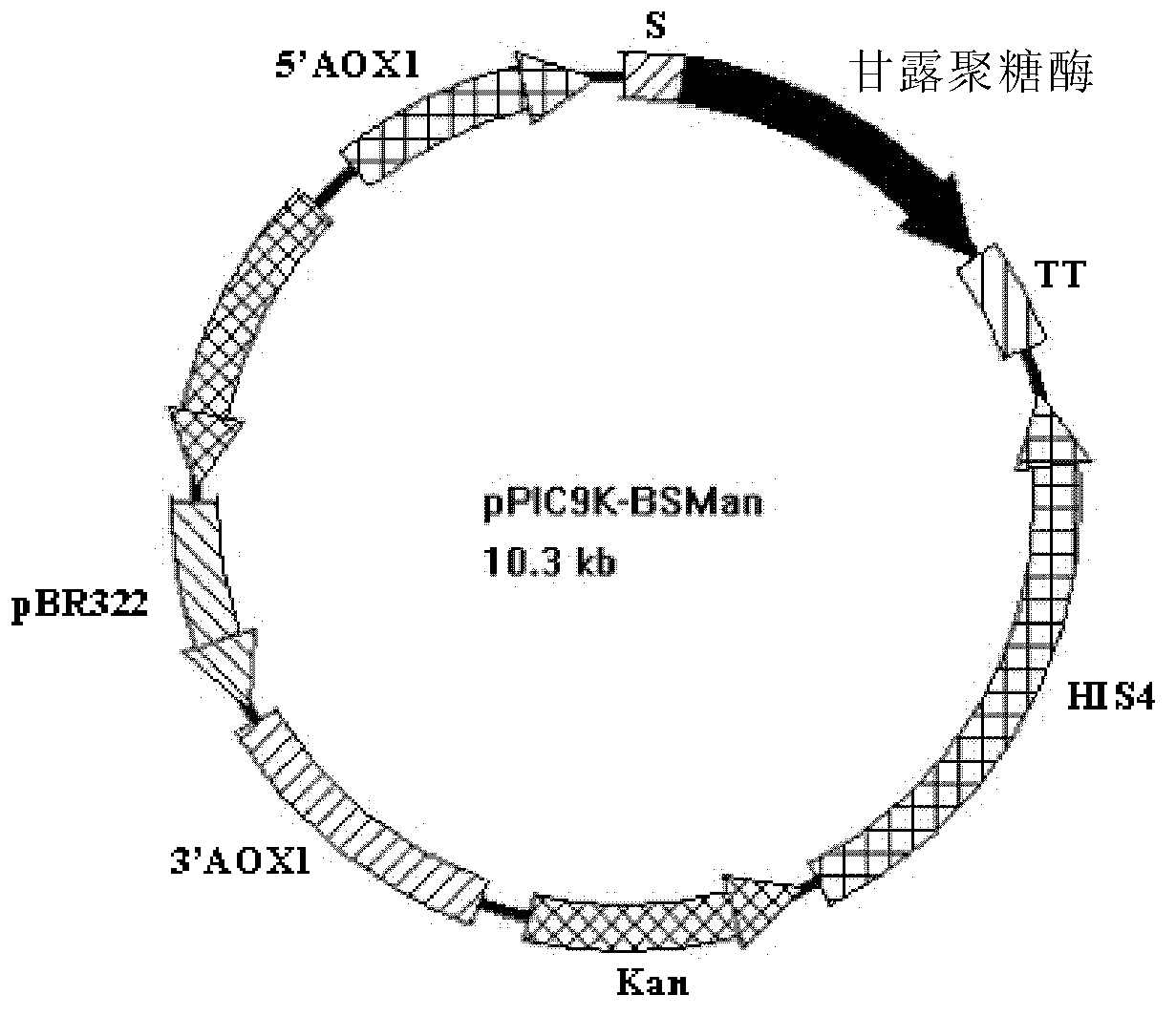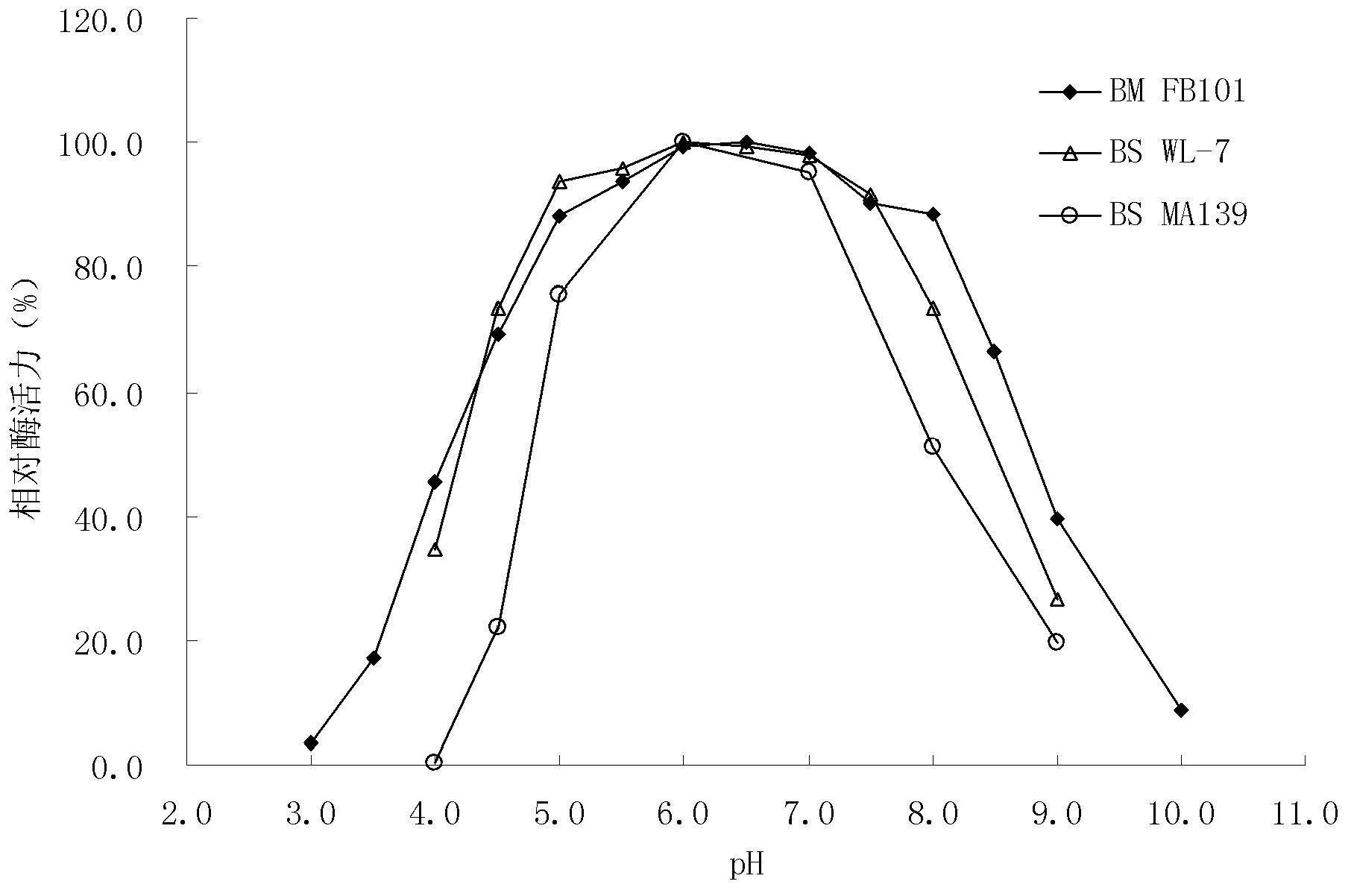Mannanase, coding gene and production thereof
A mannanase, encoding technology, applied in the direction of glycosylase, microorganism-based methods, enzymes, etc., can solve the problem of lack of high-quality enzyme sources, and achieve good resistance to protease hydrolysis, good pH stability, The effect of good thermal stability
- Summary
- Abstract
- Description
- Claims
- Application Information
AI Technical Summary
Problems solved by technology
Method used
Image
Examples
Embodiment 1
[0138] The separation of embodiment 1β-mannanase source bacteria
[0139] The β-mannanase source strain was isolated from a soil sample in Zhongshan Park, Xiamen, China.
[0140] Specifically, in order to isolate the source strain of β-mannanase, soil samples from Xiamen Zhongshan Park were collected, suspended in sterile water, and diluted, and then the suspensions of different samples were inoculated on agar-free LB medium , followed by culturing at 15°C, 20°C, 25°C and 30°C for 1-2 days, respectively. Next, the DNS method (as described in 4.1 "Methods for Determination of β-Mannanase Activity") was used to measure the β-mannan activity in culture medium and cell disruption solution of different samples at different temperatures. β-mannanase activity can be detected in the culture medium, indicating that these strains have secreted β-mannanase.
[0141] First select the sample with β-mannanase activity, and determine its appropriate culture temperature is 30°C, spread it o...
Embodiment 2
[0142] Example 2 Characteristic Analysis of β-Mannanase Source Bacterial Strain FB101
[0143] The Bacillus megaterium FB101 strain isolated in Example 1 was determined as a Gram-positive bacterium by Gram staining. This bacterium is a typical bacillus with a similar size to Bacillus megaterium under the microscope. Some of its physiological and biochemical properties were further studied.
[0144] The results showed that the bacterial strain was a Gram-positive aerobic bacterium, rod-shaped, round-ended, single or arranged in short chains, with a diameter of 1.2-1.5×2.0-4.0 microns and capable of movement. Spores are 1.0~1.2×1.5~2.0 microns, oval, mesogenic or subterminal. Its optimal growth temperature is 30°C, aerobic, and can be observed under an optical microscope. The 16s rRNA of the bacteria was determined (Shanghai Sangong), and the 16s rRNA sequence of the bacteria was compared with the reference sequence in GenBank by using BLAST and the multiple sequence alignmen...
Embodiment 3
[0146] Example 3 Cloning and acquisition of the gene encoding Bacillus megaterium β-1,4-mannanase
[0147] Extraction of genomic DNA: Cultivate Bacillus megaterium FB101 isolated in Example 1 at 30°C with nutrient broth medium (peptone 10.0g, beef extract 3.0g, sodium chloride 5.0g, distilled water 1000ml, pH7.2-7.4) Strain 3 to 4 days, to the cell concentration OD 600nm 0.5 to 0.8. Take 50ml of the cultured bacteria solution, centrifuge at 10000rpm for 10min, take 50mg of bacteria and add 500μl of sterile water to wash, and centrifuge to get the precipitate. Resuspend the precipitate in 500μl 1mg / ml lysozyme solution, incubate at 37°C for 30min, then add 100μl 1mg / ml lysozyme solution and keep warm for 30min at 40-50°C until the bacterial solution is transparent, add 10% SDS to The final concentration was 2% (m / v), stirred for about 5 minutes until the viscosity of the bacterial liquid decreased significantly, and centrifuged at 15,000 rpm for 10 minutes to remove debris. ...
PUM
| Property | Measurement | Unit |
|---|---|---|
| molecular weight | aaaaa | aaaaa |
Abstract
Description
Claims
Application Information
 Login to View More
Login to View More - R&D
- Intellectual Property
- Life Sciences
- Materials
- Tech Scout
- Unparalleled Data Quality
- Higher Quality Content
- 60% Fewer Hallucinations
Browse by: Latest US Patents, China's latest patents, Technical Efficacy Thesaurus, Application Domain, Technology Topic, Popular Technical Reports.
© 2025 PatSnap. All rights reserved.Legal|Privacy policy|Modern Slavery Act Transparency Statement|Sitemap|About US| Contact US: help@patsnap.com



